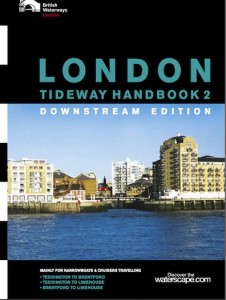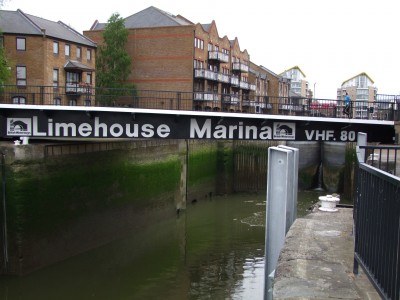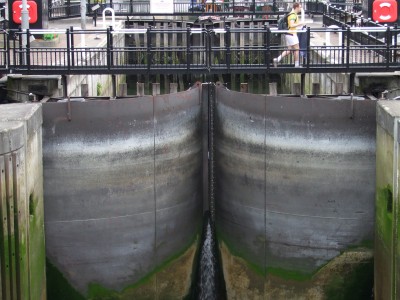| Note: It is very important that you understand how the time of your booked arrival at Limehouse relates to High Water there (same as at London Bridge). Consult the PLA tide tables (remember they are in GMT) or ask the lockkeeper. The “normal” timings imply arriving between 3 and 3.5 hours after HW. As noted below, earlier arrival times become increasingly problematic, and eventually not feasible. |
Top Tips
Last updated: 09-08-2022 @ 05:36.
- Make sure your boat is fit for the tideway
- Give the Limehouse Lock Keepers a ring at least a day in advance, and make a booking. Contact numbers are here. You should aim to arrive 3 to 3.5 hours after HW.
- Make sure you have a copy of the relevant tideway handbook – see links below
- Check the tide times, links on this page
- Aim to leave 30-60 mins before HW Teddington if you can, ie at or shortly after HW London Bridge. This should ensure (unless you are very slow!) that you arrive at Limehouse while there is still sufficient water to get over the cill into the lock. This will be approx 3 to 3.5 hours after High Water
- For various reasons Limehouse may offer you an earlier later slot ie HW+2. This make the Teddington to Limehouse trip VERY PROBLEMATIC – you should aim to leave Teddington at least 2 hours before HW, depending on the speed of your boat, in order to be confident of arriving in time. It may be more sensible to go via Brentford. If you don’t get to Limehouse in time you face a long wait (8 hours) on the outer pontoon, which can be very uncomfortable.
- Check the PLA Notices to Mariners – click here
- Make sure you boat is prepared – check lists are a page still in development but here it is
- Have your anchor ready to deploy – 15m of 10mm chain and 35m of 14mm rope please – it can be very deep out there
- Check the weather forecast, we don’t like going out if predicted winds are more than 15mph. Met Office, or Met Check
- Make sure you understand the workings of Richmond ‘half tide’ lock. (link to Richmond Lock information).
- If appropriate please call London VTS to advise them that you have left the Tideway
Planning your cruise:
Information Resources:
Click here for our list of other useful publications (page still under development) and this page for all cruising guides.
Timing:
Aim to leave Teddington at HW London Bridge, so 60 minutes before HW Teddington. The lock often gets busy at high water so head for the lock 10 minutes before those times, you can always drive a bit slower for the first 10 minutes if you go straight through. This should get you to Limehouse 2.5 to 3 hours after High Water, when there will be enough water to get into the lock.
Teddington Lock can be used at any state of the tide
Richmond Half-tide Barrier is raised 2 hours before and after local high tide. If the barrier is down then you will need to use the lock at Richmond to continue upstream.
Limehouse Lock needs enough water over the cill before you can enter – you can generally enter the lock in the period 2 hours before and 2 hours after low tide (London Bridge). This makes timings quite important: The guides all recommend allowing 3½ hours for the journey (yes we know some who shall remain nameless do it a lot faster) so if you leave 30 minutes after high tide then you will arrive at Limehouse just on time for the cill. Don’t stop for a cup of tea.
For various reasons Limehouse may offer you an earlier later slot ie HW+2. This make the Teddington to Limehouse trip VERY PROBLEMATIC – in this case you should aim to leave Teddington at least 2 hours before HW, depending on the speed of your boat, in order to be confident of arriving in time. It may be more sensible to go via Brentford. If you don’t get to Limehouse in time you face a long wait (8 hours) on the outer pontoon, which can be very uncomfortable.
Booking Locks:
| Lock | Manned | Booking Details |
| Teddington | 24-hours | Booking not necessary but the lock-keepers are a useful source of information.Telephone: 020 8940 8723, Postcode: TW11 9NG |
| Richmond Lock | Lock foreman available 24 hours – lock must be used when half-tide barrier is closed | If you follow the timings that the Tideway guides recommend then you will get to Richmond as the barrier is opening. At other times ring in advance to check the opening time of the Richmond half-tide barrier. Telephone: 020 8940 8723, Postcode TW10 7AQ (link to Richmond Lock information) |
| Limehouse Lock | Normal working hours are:0800-1800 daily Apr-Sep; 0800-1600 Oct-Mar; |
Outside of normal working hours you must book. Even if you expect to get there in normal working hours we suggest booking. Their telephone number is 020 7308 9930 or 07766 774726, mobile probably best rather than VHF Channel 80 – NOT channel 80A – they’ll hear you but you won’t hear them. Post Code E14 8EG |
Notes:
- Check tidal lock availability during public holidays such as Christmas and New Year; ‘normal’ lock working hours may vary between the summer and winter periods.
- Check sunset / sunrise times eg here as it is a load easier to cruise in daylight hours
Navigation Notes:
Specific Notes for this trip:
- Some days London VTS can hear VHF transmissions from Teddington, it does depend on atmospherics and your aerial but unless you have a large aerial it is easier to give London VTS a ring (o20 3260 7711) as you leave Teddington and tell them that you are a XX foot pink narrowboat with XX persons and YY dogs on board heading for Limehouse. They will often give you a few hints about bridge arches if they have time, remember London VTS are busy guys, will tell you off if you do something wrong but they are your best mates on the tideway and always keen to hear from you.
- The first part of the journey is relatively slow, once the tide starts running properly you will start speeding. Bear this in mind as you approach bridge or any sort of obstacle, line yourself up early, aim to be on the right line by the time you are halfway to the bridge
- It can be a bit bouncy as you approach Westminster. The main thing you want to do is to make sure that as far as possible big waves don’t hit you broadside so turn into the wash if it is coming towards you from the front, turn away if it is coming from behind you. You are unlikely to manage to hit the bow wave square on, don’t worry, just try to avoid them hitting you broadside.
- As you go under Tower Bridge give Limehouse a call either on 07766 774726 or on 020 7308 9930, VHF on ch 80 may work.
- Approaching Limehouse Lock: There is more information about approaching Limehouse lock here. The headlines are:
- Entering Limehouse Lock: There are several techniques for entering Limehouse Lock cut – we recommend the method advised by the lock-keepers which is go past the lock, turn round and come back against the tide
- We suggest informing London VTS, preferably via Channel 14 VHF) that you are about to cross the tideway – all river traffic will hear your broadcast and be aware of what you are planning. If you don’t have a VHF radio then it’s worth ringing London VTS to tell them that you are planning to cross the tideway and to check whether there is any ‘through’ traffic in the vicinity.
- be aware of commercial traffic travelling to/from Canary Wharf pier (just downstream of Limehouse)
- maintain a keen 360 degree watch
- be visible – if you’re crossing the tideway when there are low light conditions use your standard navigation and steaming light but also put your cabin lights on.
More General Notes for the Tideway:
- VHF: You must have a VHF radio unless you are in a convoy or come under one of the exceptions – see the PLA web site. Even if you are an exempt boat, we recommend having a VHF radio as you can maintain a listening watch on CHANNEL 14 whether or not you are a licensed user. In particular, listen for the river broadcasts at 15 minutes and 45 minutes past the hour – these give up-to-date information about the state of the tide, any bridge restrictions and other navigation information e.g. unusually large or fast-moving traffic.
- Do have your anchor ready to deploy, if you are in trouble throw out your anchor sooner rather than wait till the tide has you pinned up against a bridge pier.
- Navigable Arches: The navigation channel under each bridge is clearly marked in the tideway handbook (see link above); but if you don’t have a copy or there are any local changes e.g. to allow for bridge works then the navigable arch will be marked by two amber lights – there may be more than one navigable arch – in that case, choose the one which seems the most sensible taking into account factors such as the current, obstructions such as moored barges and oncoming traffic. If you are going under a large central arch which is shared by downstream and upstream traffic, then stay to the right of centre; if you are passing through a one-way arch then aim to stay in the centre. Avoid passing to close to the bridge supports – the flowing tide can sweep you into the piers and pin you there. Listen to the river broadcasts as they give information on any arch closures on that day
- Get your crew helping with navigation, you need to be thinking of which arch you are going through now and at the next bridge.
- Non-navigable arches: These are marked by an inverted triangle of red discs (red lights after dark) – DO NOT pass through a non-navigable arch – there may be shallows, underwater obstructions or even divers (in the case of bridge works).
- Headroom: Headroom at some bridges e.g. Hammersmith Bridge may be restricted during very high (spring) tides – be aware of your air draft, the predicted height of the tide and the state of the tide at the time you will be passing. Restricted headroom under some arches may be indicated by a bale of straw suspended from the bridge.
- Isophase lights: These are bright white flashing lights on bridge arches – these lights indicate that the arch will be used by a large commercial vessel e.g. container barge with poor manouverability. Keep a good look-out and use an alternative marked navigable arch – it is your responsibility to get out of the way when these large barges are passing under bridges.
- Rowers do all sorts of things above Putney, keep a careful look out for them, really watch the distracted mad coaches as they are totally random. Worth reading the links that Simon Judge found explaining why and where rowers cross the tideway.
- Maintain a 360 degree watch the whole time, get your crew to help. Basically drive on the right, stay out of the way of the big boys but position yourself so you have room to turn into or away from the big boys bow waves.
- Sound Signals: Commercial boats on the tideway often use sound signal to let other traffic know when they are manouevering. It is worth learning the basic signals – then your 360 degree watch can include your ears as well as your eyes. The basic sound signals are listed in the tideway guide (see link above), but you may want to start with these:
- one short blast: I am moving to starboard (right)
- two short blasts: I am moving to port (left)
- three short blasts: I am moving astern (reversing)
- Four short blasts followed by one short blast: I am turning fully round to starboard (right)
- Four short blasts followed by two short blasts: I am turning fully round to port (left)
- Five short blasts (evenly spaced): I am unsure of your intentions i.e. what on on earth are you doing, get out of my way!
- Buoys on the water: You may see red or green buoys along the tideway – these mark restrictions in the channel – cause either by shoals (shallows) e.g. or marking ‘lanes’ used by rowing clubs e.g. Putney. When travelling DOWNSTREAM pass to the RIGHT of green buoys and to the LEFT of red buoys. Some of the buoys are set well out into the channel – do not be tempted to cross on the “wrong” side.
- It can be a bit bouncy as you approach Westminster. The main thing you want to do is to make sure that as far as possible big waves don’t hit you broadside so turn into the wash if it is coming towards you from the front, turn away if it is coming from behind you. You are unlikely to manage to hit the bow wave square on, don’t worry, just try to avoid them hitting you broadside.
- Approaching Limehouse Lock: There is more information about approaching Limehouse lock here. The headlines are:
- Entering Limehouse Lock: There are several techniques for entering Limehouse Lock cut – we recommend the method advised by the lock-keepers which is go past the lock, turn round and come back against the tide
- We suggest informing London VTS, preferably via Channel 14 VHF) that you are about to cross the tideway – all river traffic will hear your broadcast and be aware of what you are planning. If you don’t have a VHF radio then it’s worth ringing London VTS to tell them that you are planning to cross the tideway and to check whether there is any ‘through’ traffic in the vicinity.
- be aware of commercial traffic travelling to/from Canary Wharf pier (just downstream of Limehouse)
- maintain a keen 360 degree watch
- be visible – if you’re crossing the tideway when there are low light conditions use your standard navigation and steaming light but also put your cabin lights on.
Preparing for your cruise:
We are working up some check lists – see this page
The entrance to Limehouse Lock and Marina
Limehouse Lock with its radial gates



Thanks for this excellent guide . We have carried out this passage a few times on various boats. We are hoping to escort some friends down this year and will use this information as a passage planner. We also visit Stangate,Faversham and Medway . Thanks again for a no nonsense guide. Jon
ooh Medway, that’s a serious journey. Fantastic though!
Please note that operating window of the lock at Limehouse is mess than usual, roughly HW-2 to HW+2. This may be fixed in the next few weeks.